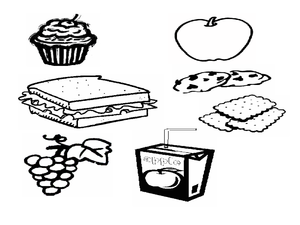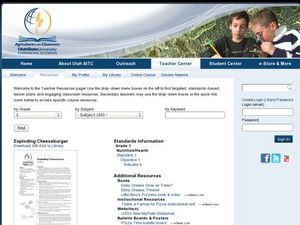Curated OER
Food Labels in the Classroom
Students read all information given on packaging; write down complete ingredients and grams of protein, carbohydrates and fat per serving. They compare the information with current health references and write a business letter to a food...
Curated OER
Hunger and Malnutrition
Sixth graders use a variety of resources to determine the importance of getting the proper nutrients. In this nutrition lesson, student complete an activity in which they examine the world issue of hunger and malnutrition. They locate...
Curated OER
The Energy Equation
Students explore human energy components. In this personal health lesson plan, students determine how food, sleep, and exercise impact human energy levels as they play BAM! Body and Mind interactive games. Students create motivational...
Curated OER
Give me Food!
Young scholars study the food guide pyramid and use it to create their own eating program.In this health lesson students visit websites to calculate their BMR, activity level and weight then create a nutrition plan
Curated OER
Engineering and the Senses
Students explore nutrition. In this nutrition lesson plan, students discuss a person's sense of taste and how it is different for each person. Students discuss favorite foods and how they relate to nutrition. Students cut out pictures of...
Curated OER
Investigating the Food Pyramid
Students examine how the food pyramid is an important nutritional tool. They classify foods and compare the number of servings per group that are necessary for maintaining good health by placing empty food containers in grocery bags.
Curated OER
Build a Burger
Second graders describe a balanced diet. In this nutrition and health lesson, 2nd graders use a hamburger to exemplify the different food groups necessary for a blanaced diet. Students use the food pyramid as a resource.
Curated OER
Hunger and Malnutrition
Fifth graders investigate hunger and malnutrition. In this hunger and malnutrition lesson, 5th graders study the importance of proper nutrition. Students explore the scope of hunger and malnutrition problems.
Curated OER
Feeding Your Fish
Students discuss nutrition and diet. They look at copies of Tetra's Daily Nutrition Pyramid for Tropical Fish. They compare the fish feeding pyramid to the pyramid for human nutrition. Students examine a can of fish food.
Curated OER
Minerals
Students compare the two main groups of minerals. In this nutritional lesson, students learn which foods contain the best source of minerals needed to maintain good health. They study the minerals that are required to be on the...
Curated OER
Label Language
Sixth graders explore healthy eating habits by identifying food labels. In this food ingredient lesson, 6th graders discuss the nutritional facts that are available on almost all foods in America and which ingredients and content is...
Curated OER
Exploding Cheeseburger
Second graders describe the components of a healthy diet. In this nutrition and health lesson, 2nd graders identify the importance in eating a variety of healthy food. Students explain what makes a healthy diet.
Curated OER
The Food Pyramid
Fourth graders plan a variety of nutritional meals using the USDA's Food Guide Pyramid as a reference and analyze food labels to plan their meals. They examine and discuss the Food Pyramid, and create dichotomous keys separating food...
Curated OER
Calorie Countdown
Fifth graders analyze their caloric intake and energy output. In this nutrition and health lesson, 5th graders use the Dietary Guidelines for Americans to evaluate their personal food intake and activity level. Students explore the...
Curated OER
Label Language
Students practice reading food labels. In this nutrition lesson, students bring in examples of food labels and practice identifying the nutrients in each of the foods. Students determine what changes should be done to the food label to...
Curated OER
Food Systems Feed the World
Sixth graders consider the source of their nutrition. In this food systems lesson plan, 6th graders discuss how food gets to the table and the process it goes through. Students reflect on world hunger issues, farming, and consumerism...
Curated OER
Vegetable Twister
Second graders study the changes in organisms over time. For this Life Science lesson, 2nd graders explore how living things react to changes in the environment. Students identify the basic needs of living things.
Curated OER
Munching on Mixtures
Students predict, observe, and record what grasshoppers eat to demonstrate an understanding that grasshoppers and people have nutritional requirements to grow and maintain good health.
Curated OER
Reading Food Labels
Fourth graders examine the food labels on two similar items that are very different nutritionally such as a can of regular soda and a can of diet soda. Next they, sort through food labels to determine healthy and unhealthy foods by...
Curated OER
A Helthy Diet
Pupils examine their eating habits and experience analyzing data and drawing conclusions. They construct models of the molecular backbone of saturated and unsaturated fats. In addition, they examine the labels of their food, record the...
Curated OER
Exploding Cheeseburgers
Young scholars identify the components of a healthy diet. In this nutrition lesson, students discuss the parts of a cheeseburger and identify the food groups the cheeseburger is a part of. Young scholars discuss how carbohydrates and...
Curated OER
Food Systems Feed the World
Fifth graders explore nutrition by viewing video clips discussing world hunger. In this malnutrition lesson plan, 5th graders discuss the reasons people cannot afford food in rural areas and read assigned text discussing our agriculture...
Curated OER
Watch Your Mouth
Students explore the effects of tooth loss to their bodies. In this oral health lesson students complete several activities that help them determine how tooth loss effects nutrition, facial structure and jaw bones.
Curated OER
Vary Your Veggies and Focus on Fruits
Third graders study a healthy diet. For this healthy diet lesson, 3rd graders investigate the nutritional value of fruits and vegetables. Students compare a healthy diet to their personal diet.

























